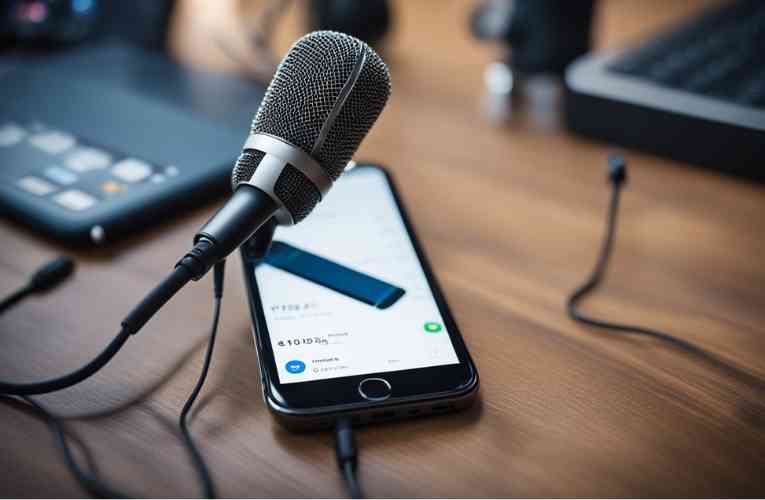Are you wondering if your iPhone provides external microphone bias voltage? If you’re looking to use an external microphone with your iPhone, it’s important to know whether or not your device can supply the necessary voltage to power the mic.
When it comes to iPhone microphone support, the device’s technical specifications can be a bit confusing. While some sources claim that iPhones do provide external microphone bias voltage, others argue that this isn’t always the case. So, what’s the truth?
In this article, we’ll take a closer look at the technical specifications of iPhone microphone bias voltage to determine whether or not your device can provide the necessary power to use an external microphone. We’ll also answer some frequently asked questions about using external microphones with iPhones.
Table of Contents
ToggleDoes an iPhone provide external microphone bias voltage?
Yes, an iPhone provides external microphone bias voltage. The bias voltage is a low DC voltage that powers the electronic circuitry inside a condenser microphone’s capsule. It is typically between 1.5 and 9.5V DC, and it is important to provide the precise amount of voltage for a given capsule design.
The iPhone’s built-in microphone uses an electret condenser microphone capsule that requires bias voltage to operate. When you connect an external microphone to the iPhone, it automatically provides bias voltage to the microphone. This voltage is necessary to polarize the diaphragm and backplate of the condenser microphone capsule, which allows it to convert sound waves into an electrical signal.
It’s worth noting that different types of microphones require different amounts of bias voltage. For example, some microphones require a higher voltage than others to operate properly. Therefore, it’s important to check the specifications of your external microphone to ensure that it is compatible with the iPhone’s bias voltage output.
iPhone Microphone Support

If you’re wondering whether an iPhone provides external microphone bias voltage, the answer is yes. The latest iPhones, including the iPhone 11 and 12, support external microphones with bias voltage. This means that you can connect an external microphone to your iPhone and enjoy better audio quality for your videos, podcasts, or other audio recordings.
External Microphone Compatibility
When it comes to external microphone compatibility, the iPhone supports a wide range of microphones. You can use a wired or wireless microphone, depending on your needs.
However, keep in mind that not all microphones are created equal. Some microphones are better suited for certain types of recordings, such as interviews, music, or voiceovers. To help you choose the best external microphone for your iPhone, check out this guide from Microphone Guru.
Lightning Connector and Audio Input
To connect an external microphone to your iPhone, you’ll need an adapter that converts the Lightning connector into an audio input. This adapter allows you to connect a 3.5mm TRRS (Tip-Ring-Ring-Sleeve) microphone to your iPhone.
Keep in mind that not all adapters are created equal. Some adapters may not work with certain microphones, or may introduce noise or other issues. To learn how to use an external microphone with your iPhone like a pro, check out this guide from Microphone Guru.
TRRS Connection and Microphone Bias
When you connect an external microphone to your iPhone using a TRRS connector, the iPhone provides microphone bias voltage to power the microphone. This bias voltage is a low DC voltage that is typically between 1.5 and 9.5 volts DC. The exact voltage depends on the microphone and the iPhone model.
Related Posts:
- iPhone 8 Plus external microphone compatibility?
- Check for External Mic Input on iPhone 6
- Belkin splitter iPhone compatibility with external microphones
Technical Specifications of iPhone Microphone Bias Voltage
Electrical Characteristics
The iPhone provides a bias voltage for external microphones. Bias voltage is a low DC voltage that powers electronic circuitry located inside a condenser type microphone’s capsule. It is important to provide the precise amount of voltage for a given capsule design. Bias voltage is usually a fixed amount of voltage, typically somewhere between 1.5 and 9.5V DC.
Microphone Power Specifications
The iPhone provides a bias voltage of approximately 2.5 volts DC on the microphone input, This voltage is designed to power electret condenser microphones, which are the most common type of microphone used for smartphones.
Limitations and Considerations
It is important to note that not all external microphones are compatible with the iPhone’s bias voltage. The iPhone’s bias voltage is not compatible with dynamic microphones or ribbon microphones, which require a different type of power. Additionally, some external microphones may require a different bias voltage than what the iPhone provides, which can result in poor audio quality or no audio at all.
In conclusion, the iPhone provides a bias voltage for external microphones, which is typically around 2.5 volts DC. This voltage is designed to power electret condenser microphones, which are the most common type of microphone used for smartphones. However, it is important to note that not all external microphones are compatible with the iPhone’s bias voltage, and some may require a different type of power.
Conclusion
In conclusion, the iPhone does provide external microphone bias voltage. This voltage is necessary for the microphone to function properly and record sound. The required impedance for the external microphone to be identified by the iPhone is around ±1650 Ohm, but this can vary depending on the microphone and its specifications.
It is important to note that bypassing the power module and connecting the microphone directly to phantom power can damage your microphone, as the bias voltage required by many Audio-Technica brand microphones is around only 1.5 to 5V DC.
Overall, understanding the electronic aspects of the iPhone’s 3.5mm audio output and microphone bias voltage is crucial for anyone looking to use an external microphone with their device. By ensuring that the microphone is compatible with the iPhone’s specifications and properly connected, you can achieve high-quality audio recordings and improve your overall recording experience.
Frequently Asked Questions
How do iPhones support external microphones?
iPhones support external microphones through their 3.5mm headphone jack or the lightning port. The 3.5mm headphone jack is compatible with most external microphones that have a 3.5mm jack, while the lightning port requires an adapter to connect to an external microphone.
What is the typical voltage provided by an iPhone for an external microphone?
The typical voltage provided by an iPhone for an external microphone is between 1.5 and 9.5V DC. This is known as bias voltage and is used to power the electronic circuitry inside a condenser or capacitor type microphone’s capsule. The exact amount of voltage required may vary depending on the microphone’s design, so it’s important to provide the precise amount of voltage for optimal performance.
Can I use a computer microphone with my iPhone, and if so, what bias voltage is required?
Yes, you can use a computer microphone with your iPhone, but you will need an adapter to connect it to the phone. The required bias voltage will depend on the specific microphone’s design and should be provided by the adapter or interface used to connect the microphone to the iPhone.
What are the specifications for microphone compatibility with iPhones?
Microphones compatible with iPhones should have a 3.5mm jack or a lightning connector. They should also be capable of receiving bias voltage within the range of 1.5 to 9.5V DC. It’s important to check the manufacturer’s specifications to ensure compatibility before purchasing a microphone.
How does the iPhone’s mic mode affect the use of external microphones?
The iPhone’s mic mode can affect the use of external microphones. When the phone is set to “speaker” mode, it will use the built-in microphone, but when set to “headset” mode, it will use the external microphone connected through the headphone jack or lightning port. Make sure to select the appropriate mic mode for optimal performance.
What should I consider when connecting a professional microphone to an iPhone?
When connecting a professional microphone to an iPhone, it’s important to consider the microphone’s impedance, sensitivity, and frequency response. The impedance should match the input impedance of the iPhone, and the sensitivity should be appropriate for the intended use. The frequency response should also be suitable for the desired application.








